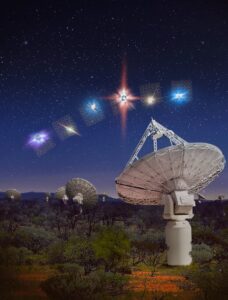
Artist’s impression of CSIRO’s Australian SKA Pathfinder (ASKAP) radio telescope observing ‘fast radio bursts’ in ‘fly’s eye mode’. Each antenna points in a slightly different direction, giving maximum sky cov-erage. Credit: OzGrav, Swinburne University of Technology
Fast radio bursts (FRBs) are enigmatic millisecond-scale bursts of radio ways so powerful that we can observe them over most of the known Universe. Their “dispersion measure” – the later arrival time of low-frequency emission compared to high-frequency emission – traces ionised gas in the Universe, allowing FRBs to probe the previously “missing matter” that we think surrounds galaxies.
Our Collaboration, “CRAFT”, has been using the Australian Square Kilometre Array Pathfinder, ASKAP, to detect FRBs, identify their host galaxies, and measure their redshifts. We have written a code, “zDM”, to use these observations to probe the matter distribution of the Universe. This project will incorporate new data from other FRB experiments, such as CHIME, MeerKAT and DSA, into our models. Running on the OzStar supercomouter in Melbourne, zDM will be used to constrain cosmological parameters such as the value of Hubble’s Constant.
| Academic background | None |
| Computing skills | Can be taught – Python will be used |
| Training requirement | Python, SLURM, bash |
| Week 1 | Inductions and project introduction |
| Week 2 | Initial presentation |
| Week 3 | Introduction to FRBs and CRAFT |
| Week 4 | Introduction to the zDM code |
| Week 5 | Implementation of new data |
| Week 6 | Test runs and code debugging |
| Week 7 | Final zDM results |
| Week 8 | Interpretation and analysis |
| Week 9 | Final presentation |
| Week 10 | Final report |